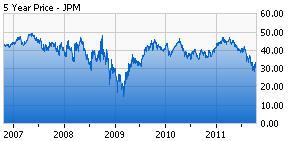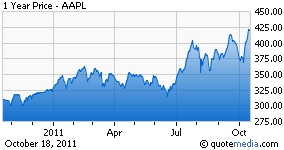We are on the brink of a revolution.
But let me tell you, this revolution doesn't involve explosive growth in Asia, the collapse of the euro, or the end of the world as we know it (although some may be wondering about that in light of today's market).
Going back to the Romans, there have only been two major revolutions in money -- the switch from coins to paper bills and the switch from paper bills to plastic cards.
Think about it -- when you get paid, how much cash actually makes it to your wallet? Do you ever physically see your money, or are you like most Americans who simply swipe a plastic card and keep track of a digital number out in cyberspace?
We've arrived at the point in this nation where it is possible to live without cash or checks. Transactions have moved to plastic, electronic transfers, direct deposits. I do, however, need my cell phone. And the ubiquitous search giant Google (Nasdaq: GOOG) is onto an idea that will put these two things together.
Google's innovation, known as Google Wallet, combines the convenience of a debit card with the popularity of a smartphone. The idea is that instead of swiping a plastic card at the checkout line, consumers will simply tap their phones on a special device that will automatically bill them for the purchase.
It may sound a little crazy. But as far as I'm concerned, this could be the next step in the payment revolution.
Here's how it works…
The system has three parts: There's a special microchip in the phone that stores account data, there's an electronic reader attached to the cash register, and, lastly, there's a customer account.
The special chip in the phone emits a highly-specialized radio signal that the reader can detec! t. This radio signal provides secure account information to the register. Instead of reading your account number off the magnetic strip on the back of your card by swiping it through a special terminal, the device picks up the number wirelessly.
The bank account at the center of this wireless phone transaction -- so far -- can be one of two things: either a prepaid account directly administered by Google, or a certain special MasterCard (NYSE: MA) account administered by Citigroup (NYSE: C).
So... you pull in to the gas station to fill up, tap your phone to a special reader on the pump, fill your tank -- and go. The receipt is emailed to you.
Now if you're thinking this idea sounds familiar, then you're right. Lots of companies have had access-card readers in lieu of door locks that use the same technology. Mobil also implemented its "Speedpass" in 1997 using the same system.
But don't let this alter your vision of the effect that Google Wallet will have going forward.
It's important to remember most breakthrough products don't just come out of nowhere. They arise from innovation and continue to be refined until they find an early adopter. From there, they begin to grow -- a process that takes, even in the digital age, a relatively long time.
In July, Wired magazine's Clive Thompson quoted Microsoft researcher Bill Buxton as saying "Anything that's going to have an impact over the next decade -- that's going to be a billion-dollar industry -- has already been around for 10 years."
That being said, I believe the time for this technology has come.
It's been predicted that a half-billion people will be using the technology within the next three years. Clearly the market is large, the technology is available and a big-name Google-branded roll-out is imminent.
What's most compelling about this impending change is the scale. This isn't one major change, it's bil! lions of the same minor change happening again and again. At first, the usual corps of affluent early adopters will gravitate toward it, but after that, the entire population is going to want in. And the demand will be such that they will get in, one way or another.
Ok, so Google Wallet will be huge. What's the investment angle? After all, I'm on the hunt for game-changing stocks... and I think Google is far too large at this point to see the sort of gains I'm looking for.
There are a couple of different ways to invest. The two main components of this system, and the two areas that could experience rapid growth, are in the hardware and software businesses.
On the hardware side, Zebra (Nasdaq: ZBRA) might make a good choice. Zebra makes RFID chips, which is one of the technologies on which contactless payment systems can be based. If you have a toll tag on your car, it likely uses RFID technology. As a leader in this field, Zebra could do well if Google Wallet becomes popular.
If you're interest is in software, then a company like Elephant Talk (OTC: ETAK) could be a smart play. Elephant Talk, based in the Netherlands, owns some unique elements of the mobile-phone business in Europe. Because it controls the operating system, it has the ability to integrate mobile-payment systems.
Because Europe is already ahead of the United States in some mobile functionality and Elephant Talk is one of the companies that made this possible, its international footprint ensures it will be part of the future.
Tags: CLF ,FCX ,SWC ,Miners Fall Hard Even as Overall Market Rises

 JP Morgan (JPM) sold off over 5% Thursday even as it produced better than expected top-line earnings, due to a poorly received conference call. Although financials have just been plain ugly this year, JPM is "best of breed" in the banking category. As such, I believe the selloff represents a buying opportunity for intrepid long term investors.
JP Morgan (JPM) sold off over 5% Thursday even as it produced better than expected top-line earnings, due to a poorly received conference call. Although financials have just been plain ugly this year, JPM is "best of breed" in the banking category. As such, I believe the selloff represents a buying opportunity for intrepid long term investors. Apple’s (AAPL) quarterly report disappointed investors with earnings per share of $7.05 vs. the consensus expectation of $7.39. And as you might expect, the stock is down in after-hours trading (around $396 as I write this).
Apple’s (AAPL) quarterly report disappointed investors with earnings per share of $7.05 vs. the consensus expectation of $7.39. And as you might expect, the stock is down in after-hours trading (around $396 as I write this).